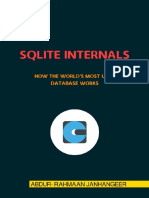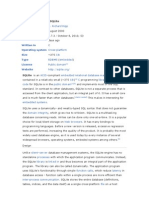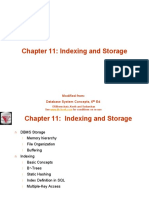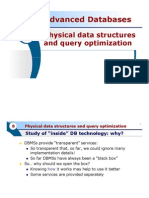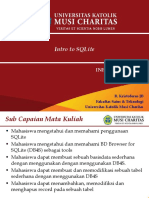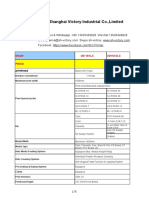FOX-IT
Extracting SQLite records
Carving, parsing and matching
22 July 2011
Ivo Pooters
pooters@fox-it.com
Pascal Arends
arends@fox-it.com
Steffen Moorrees
Moorrees@fox-it.com
1 Android data structures
The Android operating system stores most of the application data and operating system data in Sqlite
databases. Application data may consist of configuration settings and user data. Applications may
access and store the information through so-called content providers. These content providers
provide an interface to applications and regulate where data is stored and which data can be
accessed. Under the hood Android stores application data in the application directories on the user
partition. Each application has its own space on the user partition in the folder
data/<com.app.name.here>. The Sqlite databases are stored in a sub folder called databases. Often
(but not always!) the databases can be recognized by the file extension .db.
For a listing of the relevant databases and other files on an Android device, the reader is referred to
the document about Android and YAFFS2.
2 About SQLite
This section describes the SQLite file format and workings to the extent that it is relevant for carving
SQLite records. We acquired this information from the references listed in section 4. The user is
referred to these sources for more information about SQLite.
An SQLite database file consists of one or more pages. The size of the pages is a power of 2 between
512 en 65536 bytes. The actual page size is denoted in the header of the database file.
Each page is of one of the following types:
The lock-byte page
Freelist page
o Trunk page
o Leaf page
B-tree page
o Table interior page
o Table leaf page
o Index interior page
o Index leaf page
Payload overflow page
Pointer map page
Writes to the database are always an integer multiple of the page size. Reads are also an integer
multiple of the page size with the exception of a 100 byte read of the database header.
The first 100 bytes of the database file are used for the database header. The first 16 bytes of the
header contains the magic-string “SQLite format 3” including the null terminator at the end.
Sqlite has the ability to reserve a small number of bytes at the end of each page for use by extension
programs. This is called the reserved space or reserved region size. The size is stored as a 1-byte
integer at offset 20 in the database header. Usually this value is 0.
The lock-byte page, freelist pages and pointer map pages will not further be described, since these
are not relevant for carving SQLite records.
2.1 Binary tree pages
Sqlite uses a binary tree layout of pages to store indices and table content. Indices are stored in the
index b-tree pages and table content is stored using the table b-tree pages. Each table in an SQLite
schema is represented by exactly one table b-tree. Each index in an SQLite schema is represented by
exactly on index b-tree.
The index b-tree pages and interior table b-tree pages are not relevant when carving for SQLite
records, so they will not be further discussed here. For a full understanding of these pages, the
reader is referred to the sources listed in section 4.
A b-tree consists of one root b-tree page, interior b-tree pages and leaf b-tree pages. A root is
actually an interior b-tree page without a parent b-tree page. Interior b-tree pages hold keys and
pointers to child b-tree pages. Leaf b-tree pages hold keys and the corresponding content. An SQLite
program can find the value for a certain key by following the pointers from the root page down until
it encounters a leaf page. For table b-tree pages, the keys represent the row ids of the table rows.
Table b-tree root page
Internal page Internal page Internal page Internal page
Leaf page Leaf page
Leaf page Leaf page
Leaf page Leaf page
Leaf page
Leaf page
Figure 1. B-tree page hierarchy
Keys and pointers (interior pages) or keys and content (table leaf b-tree pages) are stored in ‘cells’.
The arbitrary length section of a cell is called the ‘payload’. For index b-tree pages, the payload is the
key. For interior table b-tree pages, there is no payload and for the leaf table b-tree pages, the
payload is the content.
2.1.1 B-tree page format
A b-tree page (interior or leaf) is divided into the following regions:
1. The 100-byte database file header (only on page 1)
2. The 8 (leaf) or 12 byte (interior) b-tree page header
3. The cell pointer array
4. Unallocated space
5. The cell content area
6. The reserved region (usually zero)
This is depicted in Figure 2.
B-tree page header Page header (interior) Cell pointer array
Cell pointer array Unallocated space
Unallocated space
Unallocated space Cell content area
Cell content area Res. region
Figure 2. Sqlite b-tree page layout
The cell pointer array contains pointers to the actual cells in the b-tree page. Each pointer is a 2-byte
integer which contains the offset in the b-tree page to the first byte of the cell. The cell pointers are
arranged in key order.
The cell content region contains the actual cells. Sqlite aims to place the cells as far to the end of the
page as possible to reserve space for the cell pointer array. The area between the last cell pointer
and the first cell is the unallocated space.
2.1.2 B-tree page header
The b-tree page header is formatted as follows:
1. Byte 0: A flag indicating the type of b-tree page: 0x02 indicates interior index page, 0x05
indicates interior table page, 0x0A indicates a leaf index page, 0x0D indicates a leaf table
page.
2. Bytes 1-2: Byte offset into first freeblock.
3. Bytes 3-4: Number of cells on page.
4. Bytes 5-6: Offset into first byte of the cell content area.
5. Byte 7: Number of fragmented free bytes within cell area content
6. Bytes 8-11: Right most pointer (interior b-tree pages only).
A freeblock is a structure used to identify unallocated space in a b-tree page inside the cell content
area. Freeblocks are chained by a 2-byte integer pointer at the start of every freeblock. The integer
represents the offset into the page to the next freeblock, or zero if it is the last freeblock. The third
and fourth byte of a freeblock represent the length of the freeblock including the 4-byte header. In a
well-formed b-tree page there will be at least one cell before the first freeblock (otherwise, it should
be part of the unallocated region).
Fragmented bytes are groups of 1, 2 or 3 bytes of unallocated space in the cell content area. If the
group is 4 bytes or more, it is a freeblock.
2.2 Leaf table binary tree page
The actual content of Sqlite tables is stored in the leaf table b-tree pages.
For a leaf table b-tree page, the page header is depicted in Figure 3.
Num
0x0D Offset 1st freeblock Number of cells Offset cell content
freebytes
Figure 3. Leaf table b-tree page header
Following the page header is the cell pointer array containing pointers to the cells in the cell content
area.
Each Sqlite table record is stored in one cell. The table b-tree leaf cell has the following format:
1. A varint representing the total number of bytes of payload, including any overflow.
2. A varint which is the integer key, or row id.
3. The first portion of the payload that does not spill to overflow pages.
4. A 4-byte big-endian integer representing the page number of the first overflow page. This
value is only present if payload is spilled to overflow pages.
Of course, regularly the table record content is too large to fit into one leaf page. Say, when a table
record stores a text of 2000 characters and the database page size is 1024 bytes. The single record is
too big to fit into a leaf (even if it would be the only record in the leaf page). In such a case, the
content is cut into parts such that the first part fills the available payload space in the leaf page and
the subsequent parts fit into overflow pages. If the payload size is less than U-34 then the whole
payload is stored in the leaf page. Where U is the total page size minus the reserved region size.
Sqlite overflow pages are chained by a pointer stored in the first four bytes of each overflow page.
This four byte big-endian integer represents the page number of the next page in the chain or zero in
case of the last overflow page. Each overflow page is dedicated to exactly one record.
2.2.1 Varint
A variable-length integer or "varint" is a static Huffman encoding of 64-bit twos-complement integers
that uses less space for small positive values. A varint is between 1 and 9 bytes in length. The varint
consists of either zero or more bytes which have the high-order bit set followed by a single byte with
the high-order bit clear, or nine bytes, whichever is shorter. The lower seven bits of each of the first
eight bytes and all 8 bits of the ninth byte are used to reconstruct the 64-bit twos-complement
integer. Varints are big-endian: bits taken from the earlier byte of the varint are the more significant
and bits taken from the later bytes. Listing 1 provides an algorithm outline for parsing varints.
pos = 0
value = 0
while pos < 9 and not complete:
byte = varint[pos];
if MSBset(byte) and pos < 8:
value.appendbits(byte[1:])
else if MSBset(byte) and pos == 8:
value.appendbits(byte)
set complete
else:
value.appendbits(byte[1:])
set complete
pos ++
if not complete:
error!
Listing 1. Outline algorithm for parsing varint
2.2.2 Cell and payload format
The cell format for a cell in a leaf table b-tree page is depicted below:
Payload size Row id Overfl page
Payload
(varint) (varint) num (4-b int)
The payload is in record format. The record format defines a sequence of values corresponding to
columns in a table. Each record describes both the serial type of the columns as well as the value of
the columns.
A record contains a header and a body in that sequence. The header begins with a varint
representing the size of the header in bytes (including the varint itself). Following are one or more
varints representing the column type for each column in the SQLite table. So, one varint per column.
These varints are called serial-type numbers.
The serial type numbers and their meaning are listed in Table 1.
Serial Content Meaning Our reference
type size
0 0 NULL ST_NULL
1 1 8-bit twos-complement integer ST_INT8
2 2 Big-endian 16-bit twos-complement integer ST_INT16
3 3 Big-endian 24-bit twos-complement integer ST_INT24
4 4 Big-endian 32-bit twos-complement integer ST_INT32
5 6 Big-endian 48-bit twos-complement integer ST_INT48
6 8 Big-endian 64-bit twos-complement integer ST_INT64
7 8 Big-endian IEEE 754-2008 64-bit floating point ST_FLOAT
number
8 0 Integer constant 0. Only available for schema format ST_C0
4 and higher.
9 0 Integer constant 1. Only available for schema format ST_C1
4 and higher.
10,11 Not used. Reserved for expansion.
N≥12 (N-12)/2 ST_BLOB
and A BLOB that is (N-12)/2 bytes in length
even
N≥13 (N-13)/2 A string in the database encoding and (N-13)/2 bytes ST_TEXT
and odd in length. The nul terminator is omitted.
Table 1. SQLite serial types
Note that for serial types 0, 8, 9, 12, 13 the value is zero bytes in length. Whenever a value for a
certain column is not set, then the values is stored as serial-type ST_NULL and no bytes are used for
the value.
The record format for a leaf table b-tree page is depicted in Figure 4.
Header Body
Stype Stype Stype
Header size Value Value Value
col 1 col 1 … col n …
(varint) col 1 col 2 Col n
(varint) (varint) (varint)
Figure 4. SQLite record format
3 Methodology
The goal is to extract and examine table records of SQLite databases from a file system image
independent of the file system type. This problem can be subdivided into three sub problems:
1. Identifying SQLite table records
2. Parsing SQLite table records
3. Identifying the table and database to which the SQLite records (used to) belong
The carving method described in this document has been implemented in a python program named
extractAndroidData.py.
3.1 Identifying SQLite table records
SQLite table rows are stored in the record format (we will refer to these as records) in cells in table b-
tree leaf pages. It is difficult to identify the cells or records from a table b-tree leaf page directly, as
there are no identifying header bytes. However, it is possible to identify table b-tree leaf pages with
high probability. Table b-tree leaf pages can be recognized by analyzing the first 8 bytes of the SQLite
page. To do this, one must first know the SQLite page size of the database(s). The page size is stored
in the database file header at offset 20. Usually when carving for database records, the database file
header is not available. For our method we assume the SQLite page size is known beforehand from
reference testing and it is smaller or equal to the file system page size. We define the page size as PS.
Sqlite pages are aligned with file system pages, so it is trivial to determine where the SQLite pages
page headers may be located.
3.1.1 Identifying table b-tree leaf pages
A chunk of size PS is identified as SQLite table b-tree leaf page when:
1. Byte 0 is equal to 0x0D and
2. (offset to 1st freeblock) Byte 1,2 is an integer between 8 and PS and
3. (number of cells) Byte 3,4 is an integer between 1 and PS/5 and
4. (offset to cell content area) Byte 5,6 is an integer between 8 and PS. or equal to 0
Ad 2. One could assume well-formedness of the b-tree page and say that the offset to the 1st
freeblock should be larger than the value of byte 5,6 (the offset to the cell content area) or 0. For
performance this did not appear necessary, so we chose not to make it more strict than necessary.
Ad 3. We can assume that the minimum size of a record is 5 bytes. So the number of cells in a page
should be no more than PS/5.
This heuristic is not bullet-proof, there will be cases where the chunk passes the above-mentioned
criteria, but is not a SQLite table b-tree leaf page. One should take this into account when parsing the
page.
3.1.2 Carving cells from the pages
Once the table b-tree leaf pages are identified the cell pointer map of each page can be read to
determine the location of the cells in the page.
From the cell offset, the first two varints can be parsed and decoded to the payload size and row id
respectively. If the payload size is less than or equal to usableSize – 35, then we can assume that the
entire record is in this leaf page and pass the payload to the parser as such.
If the payload size is larger than usableSize-35, The following formula calculates how many bytes are
spilled to overflow pages (from the SQLite specification):
usableSize = total page size – reserved region size
minLocal =((usable size – 12) * 32/255) – 23
maxLocal = usable size – 35
localSize = minLocal + ((payloadSize – minLocal) % (usableSize – 4)
If localSize is larger than maxLocal then minLocal bytes are stored in this leaf page and the rest is
spilled. Else, localSize bytes are stored in this leaf page and the rest is spilled.
Note that this is different from the official SQLite specification which states that maxLocal bytes are
stored on the leaf page when localSize is larger than maxLocal. However we observed that this is not
the case on the image we investigated in the DFRWS2011 challenge. We did not test this for other
SQLite databases.
Further research is required to find a method to track down the overflow pages belonging to a
certain cell. Due to time constraints we have not researched this and do not include the data in the
overflow pages.
3.2 Parsing SQLite table records
When all SQLite table cells have been identified and extracted, it is time to parse the cells into
meaningful information. During the parsing process the program should allow for the possibility that
the page was not a table b-tree leaf page after all. Any unexpected parsing errors could indicate that
it is not such a page. Analyzing the payload portion is done from left to right:
1. Determine the payload header size from the first varint.
2. For each column determine the serial type until the end of header is reached.
3. For each encountered serial type, determine the expected byte length as n of the value and
parse n bytes as the value for that column. The parser should take into account that the
actual available bytes may be less than the payload size determined by the cell in case of
overflow payload. If the payload is spilled and cannot be recovered, a dummy string is stored
as the column value.
The result is a list of recovered records. A recovered record stores the column serial types and
column values and the row id.
3.3 Identifying the database and table
For a given SQLite database the database header page and other pages will likely be stored on
spread-out locations in a file system. Without knowledge of the file structure, it is very difficult to
relate one database page to another page of the same database. As a consequence the records
cannot directly be related to pages containing the database schemas.
Before reading on, the reader should understand the difference between SQLite serial types and
SQLite data types. SQLite uses serial types to indicate the type of data stored on record level (i.e. how
they are actually stored on disk). SQLite uses data types to indicate the type as defined in a table
schema. A mapping exists to map SQLite data types to SQLite serial types and is listed in Table 2.
Note that the mapping is not one-to-one. Values of any data type which are not set, will be stored as
ST_NULL serial type.
It is assumed that the schema of the SQLite database and its table structures are known beforehand
when carving for its records. The schema can easily be acquired by examining reference databases of
the same type. This knowledge can be used to create templates for relevant tables in the database. A
template is a list of SQLite data types. SQLite data types can be any of TEXT, INTEGER, REAL, BLOB or
NULL. Where NULL is not actually a SQLite data type, but a catchall data type defined by us to match
NULL serial types.
data type Serial type
NULL ST_NULL
INTEGER ST_INT8 –
ST_INT64
ST_NULL
REAL ST_FLOAT,
ST_INT
ST_NULL
BLOB ST_BLOB,
ST_NULL
TEXT ST_TEXT,
ST_NULL
Table 2. SQLite data type map
3.3.1 Defining templates
When defining a template one should take into account columns which may contain a NULL value.
For example, a table with the following columns:
Column name data type Nullable
_id (prim key) INTEGER
Name TEXT
Protocol INTEGER
Fraction REAL no
The _id column is the primary key or row id. This means that SQLite will store the value as a NULL
value in the payload. The actual value is stored as the row id in the cell. The Name column may be
empty (NULL) when no value is set. The protocol value may also be NULL when no value is set. The
fraction value will never be NULL, because the schema defines this column as not nullable. SQLite
may store a REAL value as a ST_FLOAT serial type, one of the integer serial types (when there is no
fractional part) or ST_NULL (when no value is set).
With this information the following template can be defined for this table:
Col # SQLite data type
1 NULL
2 TEXT or NULL
3 INT or NULL
4 REAL or INT
When defining a template, the following aspects determine the data types per column:
Does the schema define whether the column is nullable?
Does the schema define a default value for the column?
According to the schema, is the data type REAL? Then the serial type may be mapped to data
type INT or REAL.
3.3.2 Effectiveness
The effectiveness of the template matching scheme is influenced by the following aspects:
The number of columns in a table schema. A record from table A with 10 columns can be
more easily matched to table A than a record from table B with 2 columns. There may exist
many more tables with 2 columns with the same column types.
The possibility of NULL values in columns. When a column can have a null data value (i.e. no
value needs to be set) then the template will be less strict. For example, a record from a
table with columns [INT (p. key), TEXT, TEXT, BLOB] where all values may be NULL can be
interpreted as a record from a table with columns [INT (p. key), INT, INT, BLOB] where all
values may be NULL.
The effectiveness can be increased when more is known about the values of columns. The templates
could be extended by defining for each column a range of possible values. For example, consider the
table:
Column name data type Nullable
_id (prim key) INTEGER
Username TEXT No
Password TEXT No
Host TEXT No
Knowing that the password is stored in clear text and the host is stored as an IP-address, the
extended template could be defined as:
Col # SQLite data type Possible values
1 NULL All integer values
2 TEXT 1 < size < 25
3 TEXT 1 < size < 25
4 TEXT 7 < size < 16 and regular expression [0-9\.]*
Due to time constraints this is not implemented in the program.
4 References
http://www.ssddfj.org/papers/SSDDFJ_V4_1_Lessard_Kessler.pdf
http://www.sqlite.org/fileformat.html
http://www.sqlite.org/fileformat2.html
http://forensicsfromthesausagefactory.blogspot.com/2011/04/carving-sqlite-databases-from.html
http://forensicsfromthesausagefactory.blogspot.com/2011_05_01_archive.html
http://forensicsfromthesausagefactory.blogspot.com/2011/05/sqlite-pointer-maps-pages.html
http://forensicsfromthesausagefactory.blogspot.com/2011/07/sqlite-overflow-pages-and-other-
loose.html





